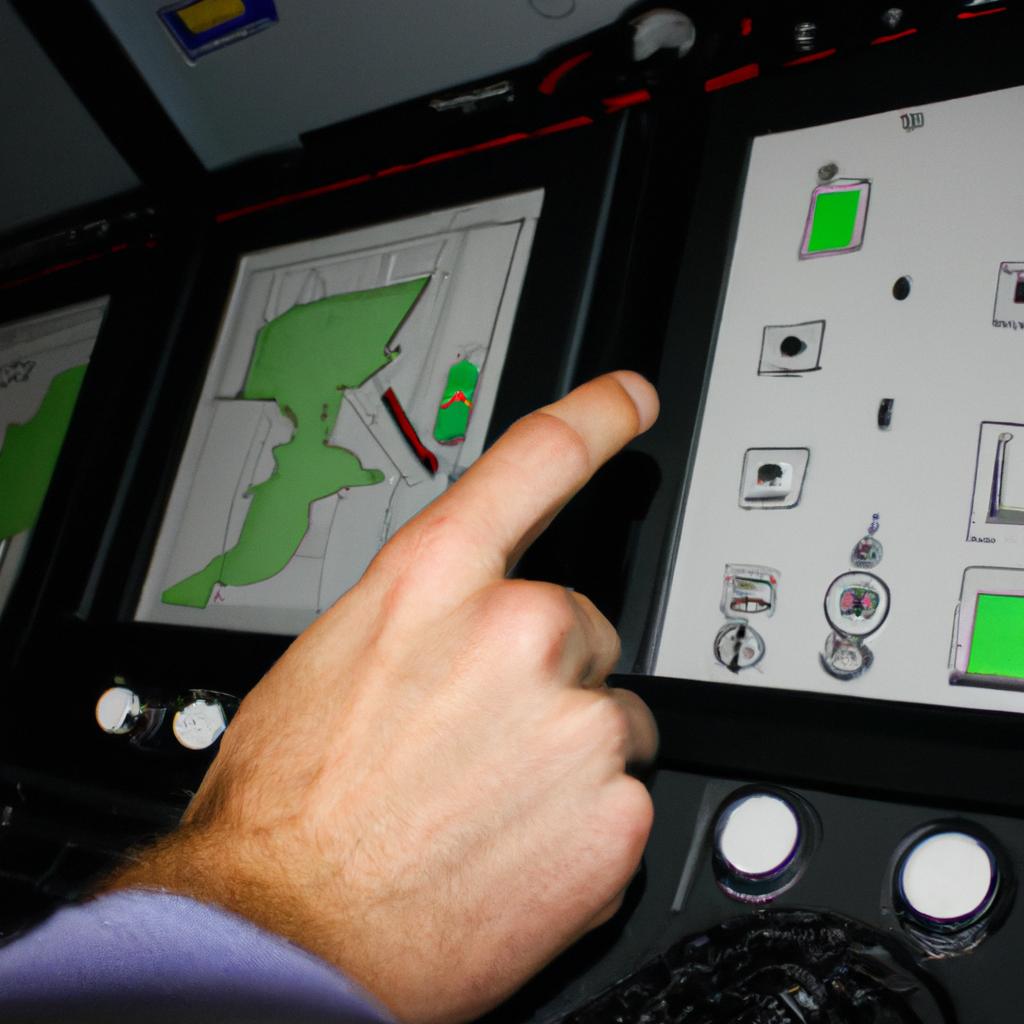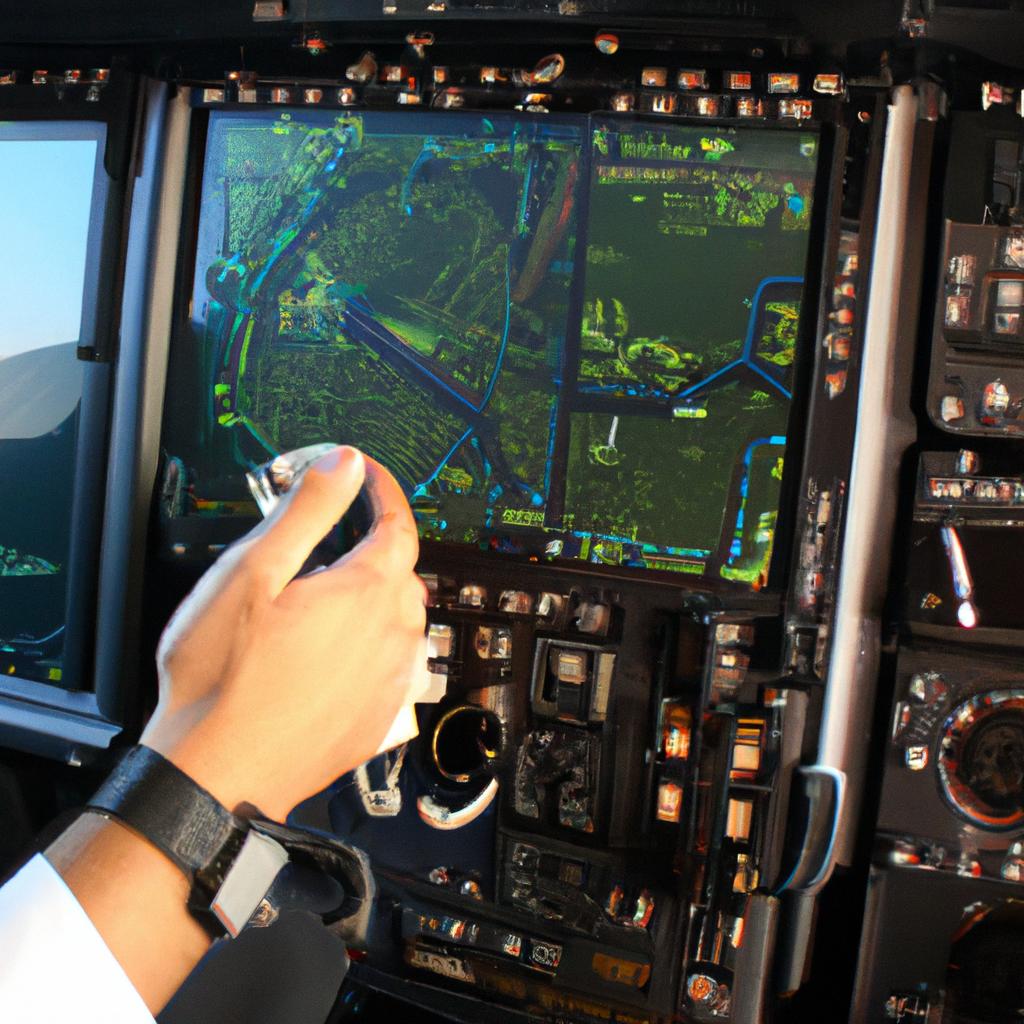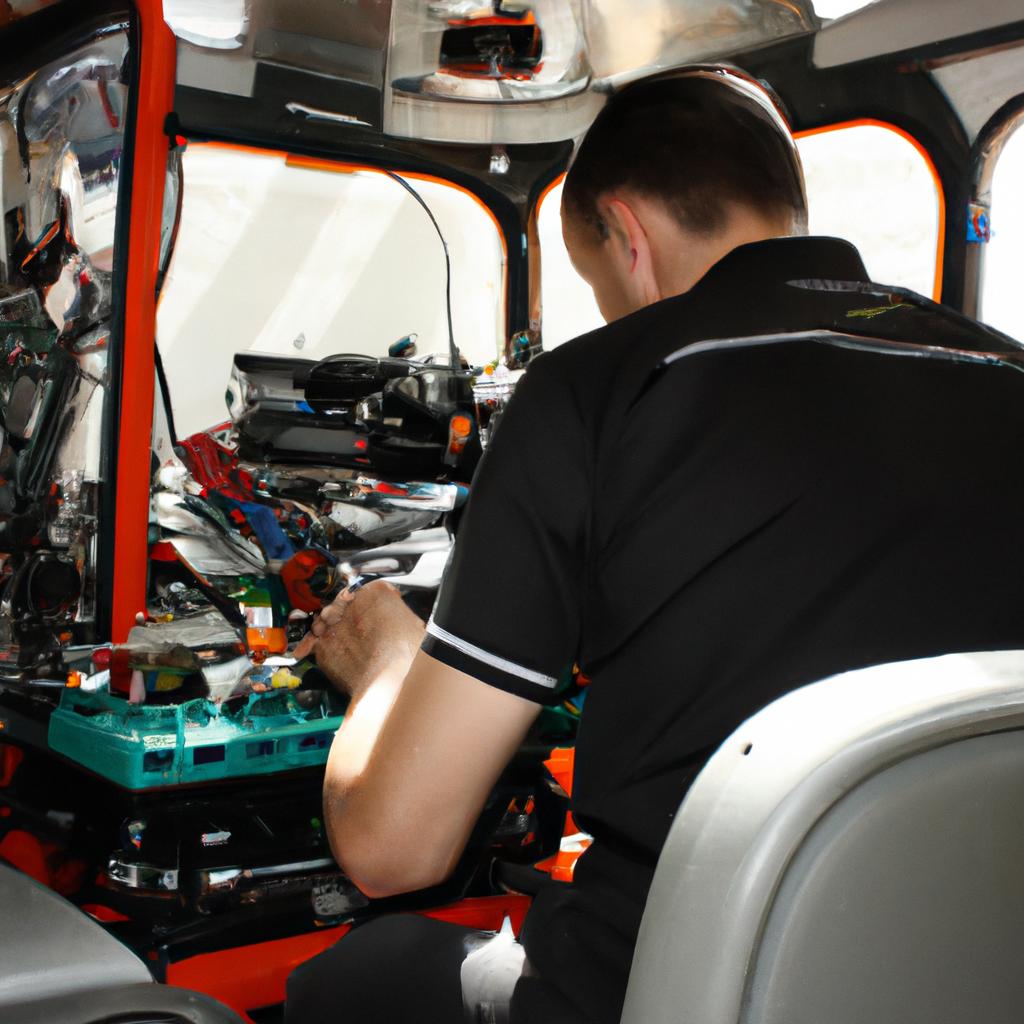Communication systems are a vital aspect of aerospace and defense avionics, ensuring seamless connectivity and information exchange in complex environments. These systems play a crucial role in enabling effective communication between various components within an aircraft or military vehicle, as well as with external entities such as ground control stations or other aircrafts. For instance, consider the hypothetical scenario of a fighter jet engaged in a mission. The pilot needs to communicate with air traffic controllers for receiving real-time updates on weather conditions, coordinating flight paths, and obtaining important instructions regarding navigation and landing procedures.
In addition to facilitating external communication, internal communication systems are equally significant in aerospace and defense avionics. Within an aircraft or military vehicle, there is a multitude of subsystems that must work together harmoniously to ensure optimal performance and safety. Communication systems enable these subsystems to exchange critical data such as engine status, fuel levels, sensor readings, and weapon system functionalities. This integration allows for efficient monitoring and management of the overall system’s health while minimizing the risk of failures or malfunctions during missions or operations. Therefore, it becomes evident that robust communication systems serve as indispensable tools for enhancing situational awareness, operational efficiency, and ultimately safeguarding valuable human lives in aviation and defense sectors.
Importance of Communication Systems in Aerospace and Defense
Imagine a scenario where an aircraft encounters engine failure during a critical mission. In such high-stakes situations, effective communication becomes paramount to ensure the safety and success of military operations or commercial flights. Communication systems serve as an essential component of aerospace and defense avionics, enabling seamless information exchange between various stakeholders involved in flight operations.
Communication systems play a crucial role in enhancing situational awareness and coordination among pilots, air traffic controllers, ground crew members, and other key personnel. By facilitating real-time data transmission, these systems enable quick decision-making and prompt action when faced with unforeseen circumstances. For instance, consider a hypothetical case study involving a military operation requiring close air support. Through efficient communication channels, ground forces can relay precise target coordinates to combat aircraft for accurate strikes while minimizing collateral damage.
To further highlight the significance of communication systems in aerospace and defense, let us examine some key advantages they offer:
- Enhanced Safety: Reliable communication ensures that pilots receive timely updates on weather conditions, airspace congestion, or any potential hazards along their flight route.
- Improved Efficiency: Seamless information flow between different entities involved leads to optimized resource allocation, reduced delays in maintenance or repairs, and enhanced operational efficiency overall.
- Better Mission Planning: Effective communication enables collaborative planning by allowing multiple parties to exchange vital information regarding mission objectives, strategies, and tactical considerations.
- Crisis Management: During emergencies or contingencies like natural disasters or hostile situations, robust communication networks facilitate swift response coordination and aid agencies’ ability to provide assistance effectively.
In addition to these benefits, it is also worth noting the various types of communication systems utilized within the aerospace and defense industry. These include voice communications (such as radios), data link systems (enabling digital information transfer), satellite-based systems (for global coverage), and encrypted communication technologies (to protect sensitive data). Understanding these different mechanisms allows for a comprehensive understanding of the communication landscape in this sector.
In conclusion, effective communication systems serve as critical components within aerospace and defense avionics. They enable real-time information exchange, enhance safety and efficiency, facilitate mission planning, and aid crisis management efforts. As we delve further into this topic, let us explore the various types of communication systems employed to meet the unique demands of the aerospace and defense industry.
Types of Communication Systems used in Aerospace and Defense
To further understand the significance of communication systems in aerospace and defense, let us consider a hypothetical scenario involving an unmanned aerial vehicle (UAV). Imagine a military operation where a UAV is deployed to gather intelligence on enemy positions. The success of this mission relies heavily on its ability to establish seamless communication with ground control stations and other assets in real-time. This example highlights the crucial role that communication systems play in ensuring effective coordination and information exchange within the aerospace and defense sector.
Effective communication systems provide several key advantages in aerospace and defense operations:
- Enhanced situational awareness: By facilitating reliable data transmission between different platforms, communication systems enable personnel to have a comprehensive understanding of the operational environment. This leads to improved decision-making capabilities and enhances overall situational awareness.
- Improved coordination: Seamless communication among various elements involved in an operation enables better coordination, resulting in synchronized actions and increased efficiency. Real-time voice and data connectivity allows for rapid dissemination of critical information, leading to swift responses when faced with dynamic situations.
- Increased safety: Reliable communication systems are essential for maintaining the safety of both manned and unmanned aircraft. They enable timely alerts about potential hazards such as adverse weather conditions or airspace congestions, allowing pilots or operators to make informed decisions to avoid risks.
- Interoperability: Communication systems that support interoperability allow different platforms from multiple organizations or nations to seamlessly communicate with each other. This fosters cooperation during joint missions or coalition efforts, enhancing the effectiveness of combined operations.
These advantages demonstrate why the integration of robust communication systems is imperative for aerospace and defense avionics. To delve deeper into their functionality and implementation, we will now explore various types of communication systems employed within these sectors.
| Advantages | Description |
|---|---|
| Enhanced situational awareness | Facilitates better understanding of operational environment through reliable data transmission |
| Improved coordination | Enables seamless communication among different elements, leading to synchronized actions and increased efficiency |
| Increased safety | Provides timely alerts about potential hazards, enhancing the overall safety of manned and unmanned aircraft |
| Interoperability | Supports interoperability between platforms from various organizations or nations, fostering cooperation during joint missions |
In the upcoming section on “Types of Communication Systems used in Aerospace and Defense,” we will further explore the specific systems utilized within this domain. These systems range from radio frequency-based technologies like secure voice communication to advanced satellite communication networks. Understanding these diverse types of communication systems is crucial for comprehending their role in avionics operations.
[Transition sentence: Moving forward into the subsequent section, let us now delve into the specifics regarding the utilization of different types of communication systems in aerospace and defense avionics.]Role of Communication Systems in Avionics
Now, let’s delve deeper into the role of communication systems in avionics. To illustrate their importance, consider a hypothetical scenario where an aircraft is flying over remote regions with limited ground infrastructure for communication. In this situation, a robust and reliable communication system becomes crucial to ensure seamless coordination between the aircraft and ground control.
Communication systems in avionics serve several essential functions:
-
Voice Communication: One primary function of these systems is to enable voice communication between pilots, air traffic controllers, and other relevant personnel. This ensures effective exchange of information regarding flight plans, weather conditions, emergencies, and any necessary instructions or directives.
-
Data Transmission: Avionic communication systems also facilitate the transmission of critical data such as navigation information, engine diagnostics, sensor readings, and surveillance data from various onboard sensors. This real-time data exchange enables accurate decision-making by both the crew and ground support teams.
-
Remote Control Operations: Advanced communication systems allow for remote operations such as unmanned aerial vehicle (UAV) control or remotely piloted vehicles (RPVs). These capabilities provide flexibility and enhance mission effectiveness without risking human lives in potentially dangerous situations.
To further emphasize the significance of these communication systems in aerospace and defense avionics, we present a bullet point list showcasing their key advantages:
- Enhances situational awareness
- Enables efficient coordination during emergency scenarios
- Facilitates precise navigation through integrated GPS technology
- Supports secure encrypted communication channels
In addition to bullet points illustrating benefits, it is useful to include a table that highlights different types of communication systems commonly employed in aerospace and defense avionics:
| Communication System | Description |
|---|---|
| VHF Radios | Provide short-to-medium range voice communications |
| HF Radios | Enable long-range voice communications |
| Satcom Systems | Utilize satellites for global voice and data communication |
| Data Link Systems | Facilitate digital data exchange between aircraft and ground |
In summary, communication systems are an essential component of aerospace and defense avionics. Their ability to enable voice communication, transmit critical data, and support remote control operations enhances overall mission effectiveness. These systems not only enhance safety and efficiency but also provide the necessary means for effective coordination in both routine flight operations and emergency scenarios.
Moving forward, we will explore the challenges involved in developing communication systems for aerospace and defense applications.
Challenges in Developing Communication Systems for Aerospace and Defense
Transitioning from the role of communication systems in avionics, it is crucial to understand the challenges faced in developing these intricate systems. One such challenge is ensuring seamless connectivity across multiple platforms while maintaining robust security measures. For instance, imagine a scenario where an unmanned aerial vehicle (UAV) deployed by defense forces needs to communicate with ground control units as well as other aircraft simultaneously. The communication system must provide reliable and secure real-time data exchange without compromising sensitive information.
To delve deeper into the challenges faced, let us consider some key factors that impact the development of communication systems for aerospace and defense:
-
Interoperability: In complex military operations involving different branches of armed forces or international collaborations, interoperability becomes paramount. Ensuring that diverse communication equipment can seamlessly interact and share information poses significant technical hurdles.
-
Bandwidth Limitations: As technology advances, there is an increasing demand for higher bandwidth to support various applications like video streaming, radar imaging, and remote sensing. However, limited frequency spectrum allocation makes it challenging to meet this growing requirement efficiently.
-
Cybersecurity Threats: With the rising sophistication of cyber threats targeting critical infrastructure, safeguarding communication systems against unauthorized access and potential tampering becomes a top priority. Ensuring resilience against hacking attempts requires constant monitoring and application of advanced encryption techniques.
-
Environmental Factors: Aerospace environments are harsh due to extreme temperatures, high altitudes, vibrations, electromagnetic interference (EMI), and radiation exposure. These environmental factors pose unique challenges in designing ruggedized communication systems capable of withstanding such conditions reliably.
| Challenge | Impact |
|---|---|
| Interoperability | Complicates coordination between different entities involved in aerospace and defense operations |
| Bandwidth limitations | Hinders transmission speed of large volumes of data required for modern avionic applications |
| Cybersecurity threats | Puts sensitive information at risk and compromises mission-critical operations |
| Environmental factors | Affects the performance and durability of communication systems in harsh aerospace environments |
Overcoming these challenges requires innovative approaches, collaboration between industry and academia, and continuous research and development efforts. As technology evolves, new solutions must be explored to address the ever-growing demands of modern avionics.
Transitioning into the subsequent section on “Future Trends in Communication Systems for Aerospace and Defense,” it is evident that addressing these challenges will shape the direction of advancements in this field. By identifying potential areas for improvement, researchers can pave the way for more efficient, secure, and reliable communication systems that meet the evolving needs of aerospace and defense industries.
Future Trends in Communication Systems for Aerospace and Defense
The challenges faced in developing communication systems for aerospace and defense have spurred the exploration of emerging technologies that can enhance the capabilities of these critical systems. One such technology is satellite-based communication, which has revolutionized long-range communications by enabling real-time data sharing across vast distances.
To illustrate the potential benefits of satellite-based communication, let us consider a hypothetical scenario involving an international military coalition engaged in a joint operation. In this case, efficient and secure communication among different units from various countries is crucial for mission success. By leveraging satellite-based communication systems, commanders on the ground can maintain constant contact with their counterparts around the world, ensuring seamless coordination and information exchange. This example highlights how emerging technologies can address some of the pressing challenges faced in modern aerospace and defense operations.
In order to fully comprehend the impact of emerging technologies on communication systems within aerospace and defense, it is essential to examine key advancements currently being explored. The following bullet point list provides an overview:
- Integration of artificial intelligence (AI) algorithms into communication systems to optimize signal processing and improve reliability.
- Development of advanced encryption techniques to ensure secure transmission of sensitive information.
- Utilization of software-defined radios (SDRs) that offer flexibility in adapting to changing requirements and frequencies.
- Implementation of cognitive radio networks capable of autonomously selecting optimal channels based on dynamic environmental conditions.
Table: Advancements in Communication System Technologies
| Technology | Benefits | Challenges |
|---|---|---|
| Satellite-based communication | Real-time global connectivity | Vulnerability to jamming or cyber attacks |
| AI integration | Enhanced signal processing and system performance | Ethical concerns regarding autonomous decision-making |
| Advanced encryption techniques | Secured transmission of classified information | Constant need for updating encryption algorithms |
| Software-defined radios | Adaptability to changing requirements | Compatibility issues with legacy systems |
| Cognitive radio networks | Autonomous channel selection based on environmental factors | Complexity of implementing self-learning algorithms |
These advancements not only provide enhanced capabilities but also come with their own set of challenges that need to be addressed. It is through the exploration and integration of these emerging technologies that aerospace and defense organizations can strive towards achieving more efficient, secure, and reliable communication systems.
As we have explored the potential of emerging technologies in communication systems for aerospace and defense, it becomes evident that effective communication plays a vital role in enhancing operational capabilities. In the subsequent section, we will delve into the benefits offered by such communication systems within this context.
Benefits of Effective Communication Systems in Aerospace and Defense
Transitioning from the previous section on future trends in communication systems for aerospace and defense, it is important to explore the benefits of effective communication systems in these industries. One example that highlights the significance of such systems can be seen in a hypothetical scenario where an aircraft encounters unforeseen mechanical issues mid-flight. In this situation, efficient and reliable communication between the pilot and air traffic control is crucial for ensuring a safe landing.
Effective communication systems play a vital role in enhancing situational awareness and decision-making capabilities within aerospace and defense avionics. To further understand their importance, let us delve into some key benefits:
- Enhanced Safety: Reliable communication channels enable real-time exchange of critical information, allowing pilots, ground crew, and military personnel to promptly address potential safety concerns or emergencies.
- Improved Efficiency: Streamlined communication processes lead to better coordination among different entities involved in aerospace and defense operations, reducing delays and optimizing resource utilization.
- Increased Mission Success Rates: Clear and accurate transmission of instructions facilitates effective collaboration among team members, increasing the likelihood of mission success across various operational scenarios.
- Better Data Management: Advanced communication systems provide seamless integration with data networks, enabling faster data transfer rates, improved storage capacity, and enhanced data security.
To illustrate the impact of effective communication systems more vividly, consider the following table showcasing how they contribute to specific aspects within aerospace and defense avionics:
| Aspect | Impact of Effective Communication Systems |
|---|---|
| Flight Operations | Efficient coordination ensures smooth flight operations while addressing any arising challenges promptly. |
| Maintenance | Quick identification and resolution of technical issues through clear communication minimize downtime for maintenance activities. |
| Tactical Situations | Real-time sharing of intelligence enables rapid response to evolving tactical situations during combat missions or emergency responses. |
| Training | Seamless interaction between instructors and trainees enhances training effectiveness by facilitating clear comprehension of complex concepts. |
In conclusion, effective communication systems are an essential component of aerospace and defense avionics. By enabling efficient information exchange, these systems enhance safety, improve efficiency, increase mission success rates, and facilitate better data management. The hypothetical scenario mentioned earlier illustrates the critical role such systems play in ensuring safe landings during unforeseen circumstances. As technology continues to advance, it is imperative for industry stakeholders to prioritize investment in robust communication infrastructure to further optimize operations within these industries.
 Louth Online
Louth Online



